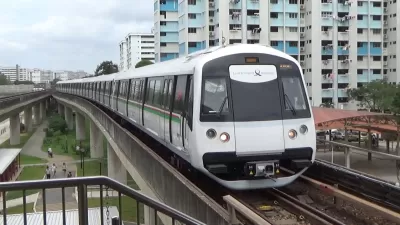Proposed restrictions on federal spending for transit railcars center on concerns about market competition and national security.

A recent Eno Center for Transportation report examines a proposed policy to restrict the use of federal funds for the purchase of transit vehicles from companies owned or subsidized by the People's Republic of China. The focus of this ban is CRRC Corporation Limited, the largest global supplier of rail transit equipment.
Proponents say the ban is necessary because CRRC is a state-owned enterprise receiving subsidies that can, as a result, underbid its competitors. They also say that CRRC will dominate the transit railcar market and move to take over the domestic freight railcar market down the road.
Opponents argue that the ban would burden American taxpayers and state and local governments, given the higher cost of transit railcars from other manufacturers. In addition, they say that domestic assembly plants for these railcars provide local jobs and encourage regional manufacturing, balancing out negative outcomes.
The report also discusses the national security concerns behind this transit railcar proposal:
Cyber threats—like spyware and malware—are a significant concern for the mass transit industry. The sector is undergoing rapid technological change as rail networks become more connected and automated, outfitted with amenities like mobile ticketing and Wi-Fi, and integrated in social networks.
The report notes that the Department of Homeland Security, as part of the National Defense Authorization Act, will be conducting a study about transit railcars manufactured by Chinese companies and national security threats.
FULL STORY: The Implications of the Federal Ban on Chinese Railcars

Alabama: Trump Terminates Settlements for Black Communities Harmed By Raw Sewage
Trump deemed the landmark civil rights agreement “illegal DEI and environmental justice policy.”

Study: Maui’s Plan to Convert Vacation Rentals to Long-Term Housing Could Cause Nearly $1 Billion Economic Loss
The plan would reduce visitor accommodation by 25% resulting in 1,900 jobs lost.

Why Should We Subsidize Public Transportation?
Many public transit agencies face financial stress due to rising costs, declining fare revenue, and declining subsidies. Transit advocates must provide a strong business case for increasing public transit funding.

Paris Bike Boom Leads to Steep Drop in Air Pollution
The French city’s air quality has improved dramatically in the past 20 years, coinciding with a growth in cycling.

Why Housing Costs More to Build in California Than in Texas
Hard costs like labor and materials combined with ‘soft’ costs such as permitting make building in the San Francisco Bay Area almost three times as costly as in Texas cities.

San Diego County Sees a Rise in Urban Coyotes
San Diego County experiences a rise in urban coyotes, as sightings become prevalent throughout its urban neighbourhoods and surrounding areas.
Urban Design for Planners 1: Software Tools
This six-course series explores essential urban design concepts using open source software and equips planners with the tools they need to participate fully in the urban design process.
Planning for Universal Design
Learn the tools for implementing Universal Design in planning regulations.
Smith Gee Studio
Alamo Area Metropolitan Planning Organization
City of Santa Clarita
Institute for Housing and Urban Development Studies (IHS)
City of Grandview
Harvard GSD Executive Education
Toledo-Lucas County Plan Commissions
Salt Lake City
NYU Wagner Graduate School of Public Service




























